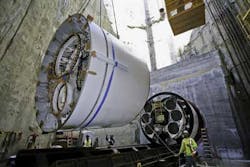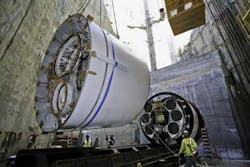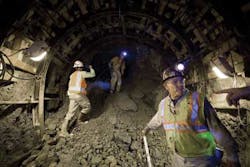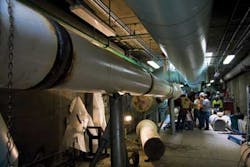San Francisco Nears End of $4.6 Billion Improvement Program
By Harlan L. Kelly
SFPUC customers are currently served by 280 miles of pipelines, 60 miles of tunnels, 11 reservoirs, five pump stations and two treatment plants that bring snowmelt from the Sierra Nevada Mountains to the cities that surround the San Francisco Bay. Pipelines and tunnels from the Hetch Hetchy Reservoir cross three major earthquake faults with the potential to interrupt water service for days and weeks.
This summer two major contracts were awarded to upgrade San Francisco's Hetch Hetchy Regional Water System. This marks the beginning of the home stretch because these contracts represent the last of 81 capital improvement projects that comprise the San Francisco Public Utilities Commission's $4.6 billion Water System Improvement Program (WSIP).
We're working our way toward total completion of the program in 2016, with construction in high gear. Although the program has been modified and refined since its inception in 2002, when San Francisco voters approved a bond measure to pay for seismic improvements, the current program includes 35 projects within San Francisco, plus 46 other projects between the Central Valley and the San Francisco county line. As we celebrate Labor Day this year, 74 of the 81 project, across seven counties, are either in construction or have been completed.
This unprecedented infrastructure development and improvement resulted in jobs at a time when they have been needed most. In 2011, approximately 2.7 million craft hours were logged on WSIP projects, which represent wages exceeding $100 million on the projects covered by a Project Labor Agreement.
Completion of the WSIP is critical. The devastation caused by the historic 1906 earthquake and the 1989 Loma Prieta earthquake remind Bay Area residents that they live in a "when" – not an "if" – environment when it comes to earthquakes.
The SFPUC provides water services to 2.6 million residential, commercial and industrial customers in four counties across the Bay Area. The WSIP is a massive and innovative effort to prevent a major water supply disruption to its Hetch Hetchy Regional Water System when an earthquake occurs. It is one of the largest water infrastructure programs in the nation, and it is the largest infrastructure program ever undertaken by the City of San Francisco.
WSIP projects in this race against time vary in size and complexity, covering all aspects of the water system – from dams, reservoirs, pipelines and tunnels to water treatment facilities, pump stations and water storage tanks. These final two recently-awarded projects, the Seismic Upgrade of the Bay Division Pipelines #3 and 4 over the Hayward Fault, as well as the Sutro Reservoir, represent the diversity of projects being managed by our team of engineers, consultants and contractors. When completed in 2016, the WSIP will safeguard the health and safety of our community even in the most severe circumstances.
The Sutro Reservoir project, for example, located in the heart of San Francisco, will provide seismic upgrades and improve reservoir circulation as well as retrofit the outlet system to conform to the latest state health requirements for water storage basins. The second project, the seismic upgrade of the two major pipelines over the Hayward Fault, is one of the most critical seismic reliability projects in the WSIP. It is located near the infamous Hayward Fault and requires a very innovative, state-of-the-art design solution that includes a large underground articulated concrete vault that could accommodate a 6.5 foot displacement of the pipeline during a large earthquake.
While the WSIP has all major projects awarded and in construction, we are facing our greatest challenges with the largest and most complex projects in construction over the remainder of the program: the Harry Tracy Water Treatment Plant-Long Term Improvements; the Bay Division Tunnel; the New Irvington Tunnel and the Calaveras Dam Replacement Project.
The Harry Tracy Water Treatment Plant project, with an approved budget of $175 million and an estimated completion date of December 2015, is approximately 15% complete. With the discovery of a new trace of the Sierra Fault during the final design, this project doubled its scope and now consists of seismic and hydraulic improvements in various treatment units including expansion of the filtration process capacity by adding five new filters. In addition, the project was forced to construct a new 11-million-gallon treated water reservoir to replace the existing two treated water reservoirs residing over the fault trace.
The Bay Tunnel, five miles long and eleven stories below sea level, is being created using a 600-foot earth balancing tunnel boring machine with trailing gear that has penetrated the first three miles and is headed through challenging terrain that includes the very sensitive habitat around the retrieval shaft in Newark, CA. As a result of the environmental constraints, the contractor has opted to use a frozen shaft method to create the retrieval shaft, and will abandon most of the TBM underground rather than risk disturbing this habitat to remove the machine. The entire $307 million project is on schedule to be completed in 2015. Once completed the final tunnel lining will consist of a 9-foot-diameter welded steel pipeline.
The New Irvington Tunnel in the Sunol region is the second of the three tunnels being built as part of the WSIP. This 18,660-foot-long tunnel has a construction budget of $238 million and is expected to reach completion in the spring of 2015 using a conventional tunneling method. This tunnel is horseshoe shaped with excavated dimensions of approximately 12 feet by 14 feet. It is being excavated through Briones Sandstone and Tice Shale rock formations, and through seven secondary fault zones in four tunnel headings. Two headings are driven from each end of the tunnel at surface portals, and two headings are driven from an intermediate 41 foot diameter by 115 feet deep shaft. In June, after 13 months of digging, miners from two of the headings met up with each other underground. This ‘hole-through' allowed the road header teams from the Irvington Portal in Fremont and the Vargas Shaft 4,500 feet away to shake hands somewhere under the mountainside and formally complete this section of tunnel excavation.
The work on this project must be conducted under a "gassy tunnel" designation from the state's health and safety agency. Originally, the tunnel was designated "potentially gassy" and then was assigned the "gassy" designation late last year. This has placed additional obligations on the construction management team and contractor for tunnel ventilation, gas monitoring, and safety practices, but they are performing at peak levels. The new tunnel alignment runs parallel and just south of the existing tunnel and will greatly assist with maintenance and redundancy priorities for the agency. The final tunnel lining will be mortar lined, welded steel pipe, resulting in an 8.5 feet finished diameter.
Our final WSIP project is the rebuilding of the Calaveras Dam in southern Alameda County, nearly 90 years old and once heralded as the world's largest earth dam. In 2001, the water levels at the Dam were lowered to less than 40 percent of original capacity because of seismic instability. The storage is crucial to providing adequate water in times of drought. Once the new dam is rebuilt, the dam will withstand a 7.2 magnitude earthquake. The new 210-foot-high earth and rock fill dam will be constructed immediately downstream of the existing dam and will have a crest length of 1,210 feet, a base thickness of 1,180 feet, and a crest thickness of 80 feet. The total volume of the dam will be approximately 3.5 million cubic yards.
Due to the location of the existing Calaveras Dam in protected watershed lands, the project faces many hurdles. These include building the new dam in such close proximity to an active earthquake fault and in an area with complex geological conditions, ensuring environmental compliance in a pristine environment with numerous threatened and endangered species, as well as the presence of naturally occurring asbestos, which is found in the Franciscan Complex mélange and serpentinite rocks. All of these factors have led to the implementation of extraordinary precautions and mitigation measures to address conditions and ensure project completion. The $416 million project broke ground in September 2011 and is currently 20 percent complete.
A smaller but just as challenging project, Crystal Springs Pipeline #2 (CSPL2), requires the SFPUC to replace and repair portions of the 19-mile-long steel pipeline that is located within a major commuter thoroughfare. First built in the 1930s, this pipeline provides drinking water to several cities on the San Francisco Peninsula. CSPL2 is also one of the most complicated pipelines to replace due to stringent environmental reviews, community relations issues and the fact that much of the pipeline lies under the Bay Area's oldest highway, El Camino Real. Millions of motorists use it annually, and more than three miles of the CSPL2 water main is located beneath it.
The contractor designed a custom pulley system for this project to slipline the new pipeline carefully through the existing pipe. The completion of CSPL2 construction work in the 18 work areas within seven Bay Area cities is scheduled for January 2013.
All these projects have undergone a very rigorous planning and environmental review process that has taken years. It had been a very long time since the SFPUC directly engaged in the types of work demanded by the WSIP, particularly with tunnels. Our strategy has helped infuse the entire SFPUC with new tools and technical expertise that will pay decades of dividends to San Francisco residents as the agency and the City apply lessons learned and replicate new technologies from the WSIP to future infrastructure improvement programs.
About the Author: Harlan L. Kelly, Jr., P.E., is the Assistant General Manager, Infrastructure, for the SFPUC, responsible for implementing over $10 billion in capital programs for water, sewer and power, including the $4.6 billion Water System Improvement Program and the $6.9 billion Sewer System Improvement Program. He is a licensed professional engineer, and a graduate of the University of California at Berkeley.



